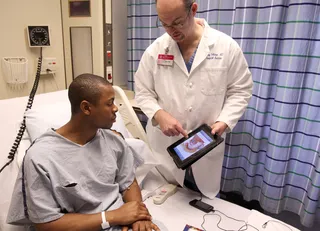July Is African-American Bone Marrow Awareness Month
New initiative calls for more Black donors.

1 / 9
Giving Back - Each year, more than 10,000 patients in the U.S. are diagnosed with life-threatening diseases such as leukemia or lymphoma and need a bone marrow transplant. But imagine if you or your loved one was sick and couldn't find a donor simply because there weren't enough people in the database to match your DNA. Because donor-patient matches are most likely found within people of the same ethnic group, that grave circumstance is a reality for many Blacks with bone marrow disease, as only seven percent of the 10 million people registered in the national Be The Match Registry are Black. As The National Bone Marrow Donor Program (NMDP) has designated July as African-American Bone Marrow Awareness Month, BET.com shows you ways you can help. –Britt Middleton (Photo: Courtesy National Marrow Donor Program)

2 / 9
What Is Bone Marrow Disease? - Bone marrow is the soft tissue found in some bones, including your hip and thigh bones. It contains stems cells, which can develop into the red blood cells that carry oxygen through your body, the white blood cells that fight infections and the platelets that help with blood clotting, the National Institute of Health writes. Bone marrow disease is the result of problems with the stem cells or how they develop and can be onset by your genetic makeup or environmental factors. (Photo: Ed Reschke/Getty Images)

3 / 9
How Is a Bone Marrow Disease Diagnosed? - Bone pain, achy joints and headaches can all be symptoms of bone marrow disease, though symptoms vary depending on the type of disease. A doctor can extract a small sample of bone marrow through a needle or extract a small piece of bone marrow tissue to check if the bone marrow is healthy. Leukemia, a cancer in which the bone marrow produces abnormal white blood cells, and aplastic anemia, where the bone marrow doesn't make red blood cells, are two common types of bone marrow disease. (Photo: Duncan Smith/Getty Images)

4 / 9
What are the Treatment Options? - Treatment can range from prescription drugs to blood transfusions or a bone marrow transplant. African-Americans have a greater challenge than people of other races in finding bone marrow matches because of generations of race mixing spanning North America, West Africa and Europe. (Photo: Essdras M Suarez/The Boston Globe via Getty Images)
Photo By Essdras M Suarez/The Boston Globe via Getty Images

5 / 9
How Are African-Americans Affected by Shortage of Available Donors? - Of 10 million people registered with the Be The Match Registry, just 685,000 (7 percent) are African-American, this compared to 6.8 million that are white, the organization reports. The chance of finding a match on the Be The Match Registry is close to 93 percent for whites, but for African-Americans and other minorities, the chances can be as low as 66 percent. About 70 percent of patients in need of a transplant do not have a matching donor in their family and depend on the Be The Match Registry, according to the organization. (Photo: LUCY NICHOLSON/Landov)
ADVERTISEMENT

6 / 9
Raising Awareness - Days after Good Morning America host Robin Roberts announced that she suffered from myelodysplastic syndromes (MDS), a rare bone marrow disorder, support for bone marrow donation spiked dramatically. “In a typical day the registry receives 200 to 300 registrations. In the 48 hours following the Robin Robert’s announcement 3,500 people joined,” Kirsten Lesak-Greenberg of the NMDP's Be The Match Registry, told EurWeb.com (Photo: Ethan Miller/Getty Images)

7 / 9
A Common Myth About Becoming a Donor - One common misconception is that all donations involve surgery. A peripheral blood stem cell (PBSC) donation is a non-surgical option commonly requested by doctors and done in a blood center outpatient hospital, in which your blood is drawn through a needle in one arm and passed through a machine that separates out the blood-forming cells. If surgery is needed, such as in a bone marrow donation done at a hospital, donors typically go home the same day. (Photo: David Ramos/Getty Images)
Photo By Photo: David Ramos/Getty Images

8 / 9
Is Donating Painful? - Because donors will take a drug called filgrastim for five days before their donation, PBSC donors may experience headaches, joint or muscle aches, or fatigue. Marrow donors are given anesthesia before the procedure, in which bone marrow is harvested from the back of the pelvic bone, and can expect to feel some soreness in their lower back for one to two weeks afterward. In both cases, most donors are back to normal activity within a week. (Photo: Justin Sullivan/Getty Images)
